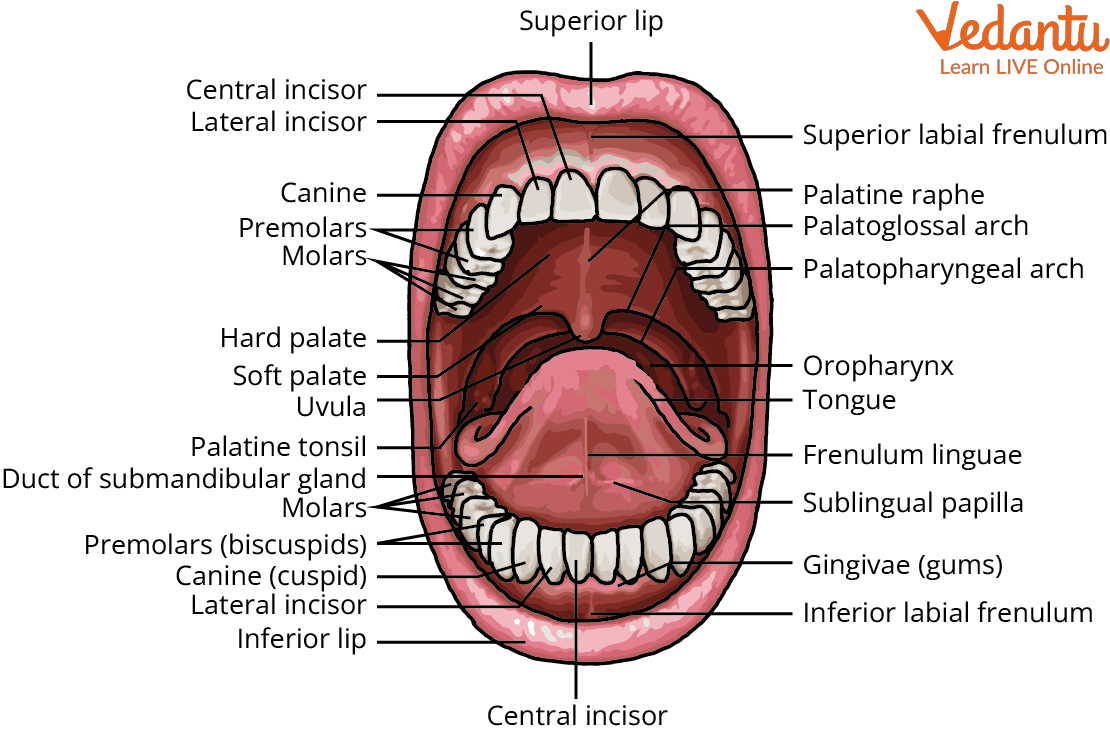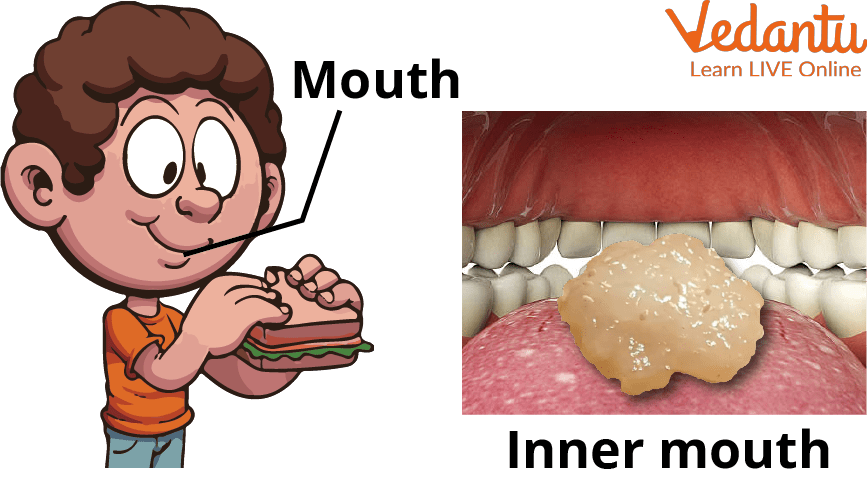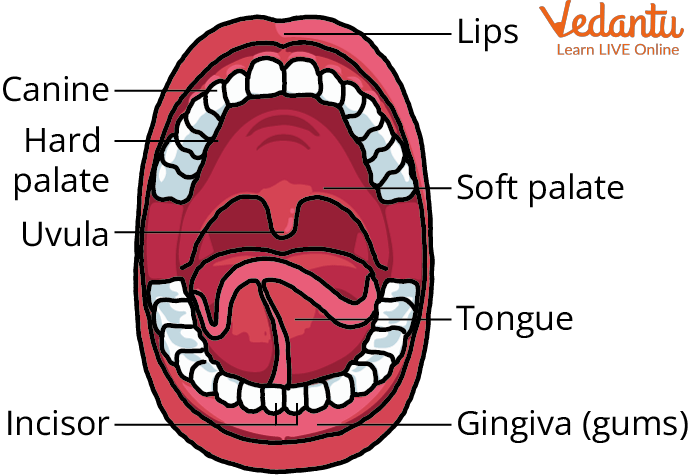




Introduction to Different Parts of the Mouth
The mouth is a cavity inside the skull which is oval in shape. The mouth's two primary functions are eating and speaking. The lips, vestibule, mouth cavity, gums, teeth, hard and soft palate, tongue, and salivary glands are all parts of the mouth. The oral cavity or buccal cavity are other names for the mouth. Eating, speaking, breathing, digesting food, and smiling are all activities. It consists of many components. Some are complex.
Cheeks and Lips
This dynamic duo consists of powerful muscles. They enable you to smile, frown, kiss and communicate. They also serve as a guide to keeping your teeth in the proper position.
Tongue
You can thank your tongue the next time you say, "That's delicious!" It, along with other parts of your mouth, contains approximately 10,000 taste buds, allowing you to taste sweet, savoury, salty, and bitter flavours.

Parts of the Mouth
However, your tongue serves multiple functions, including speaking, chewing, and swallowing.
Alveolar Bone, Teeth, and Gums
Here's something to be cheerful about and with Your pearly whites. They are made of hard enamel with roots that connect to your jawbone. The alveolar bone surrounds the roots and aids in the retention of your teeth. Your gums hold everything together, preventing your teeth and roots decay.
Glands of Saliva
Your salivary glands are responsible for producing (you guessed it) saliva. This aids digestion by breaking down food and putting moisture in your mouth so you can speak, chew, and swallow. Saliva also aids in the prevention of cavities and gum disease by repeatedly washing bacteria from your teeth and gums. There are three pairs of main salivary glands and hundreds of minor ones in your body. Your salivary glands play an essential role in chewing, swallowing, and maintaining proper oral hygiene. They can be found in your head and neck. Two parotid glands (the largest), two submandibular glands, and two sublingual glands are among the three major glands. In addition, minor salivary glands can be found all over your oral cavity, including your cheeks, mouth, palate, and sinuses.
TMJ (Temporomandibular Joint)
The temporomandibular joints enable you to open and close your mouth and move your lower jaw forward and side to side. These two joints also help you speak, chew and swallow.
Tips for Maintaining the Health of Your Oral Cavity
A good oral hygiene routine. Brush and floss your teeth twice daily.
Maintain regular appointments with your dental professionals.

Inner Mouth
How to Keep the Teeth Healthy
Offer a wholesome diet. Reduce your intake of juice, sweet snacks, and sticky foods like dried fruit.
Attend routine dental examinations.

Parts of the Oral Cavity
Assist younger children in twice-daily, two-minute tooth-brushing. Then, when the teeth are in contact, encourage your youngster to begin flossing once per day.
In sports where there is a chance of mouth injury, insist that your child wear a mouthguard.
Teach your kid never to run or walk with anything in their mouth, such as a pencil or a toothbrush.
If your child is still sucking their thumb or using a pacifier by the time they turn four, consult a doctor or dentist. They can provide you with advice on how to get your child out of the habit.
Summary
From the article, as mentioned earlier, we can make the children aware that the human mouth is divided into several sections. The lips encircle the outside of the mouth. The cheeks form the sides of the mouth, and the bottom by the floor. Small tubes in the foot and cheeks allow saliva to enter the mouth. The upper part of the mouth is called the roof. It consists of two parts.
On the front, there is flesh covering the bone. The back part is soft flesh. The uvula is a small piece of meat that hangs from the roof of the mouth in the back. Two teeth grow from the top and bottom of the mouth, behind the lips. Before swallowing food, a person chews it with their teeth. The tongue helps make speech sounds. Gums cover the teeth and attach them to the jawbone.
FAQs on Parts of the Mouth: Learn and Explore the Anatomy
1. What comprises the mouth's primary components?
The human mouth is divided into several sections. The lips encircle the outside of the mouth. The cheeks form the sides of the mouth, and the bottom by the floor. Small tubes in the foot and cheeks allow saliva to enter the mouth. The teeth, tongue, salivary glands, tonsils, back of the throat, and epiglottis are all mouth parts, commonly known as the oral cavity. The mouth is a crucial organ because it aids in breathing, eating, digesting, speaking, and communication.
2. What use does the buccal cavity serve?
The buccal cavity, also known as the oral cavity, is the start of the alimentary canal, which leads to the pharynx and then to the oesophagus. It is divided by the palate and serves as an entrance to the digestive system. It is made up of the teeth, tongue, and palate. The alimentary canal, which connects the buccal or oral cavity to the pharynx and oesophagus, starts here. The teeth, tongue, and palate make up this opening to the digestive system, divided by the palate.
3. What four types of teeth are there?
Human teeth are composed of four distinct tissues: pulp, dentin, enamel, and cementum. The pulp is the innermost portion of the tooth and is made up of connective tissue, nerves, and blood vessels that provide nutrition to the tooth. Something to be pleased about and with Your pearly whites. They are made of hard enamel with roots that connect to your jawbone. The alveolar bone surrounds the roots and aids in the retention of your teeth.
The four varieties of teeth are:
Incisors
Canines
Premolars
Molars









